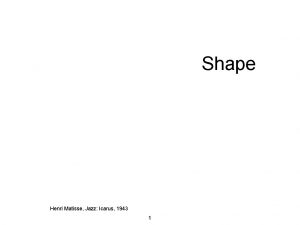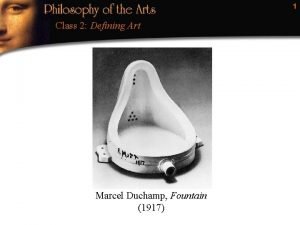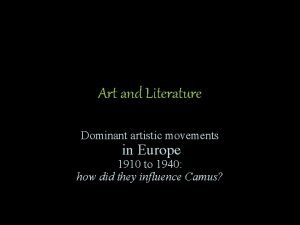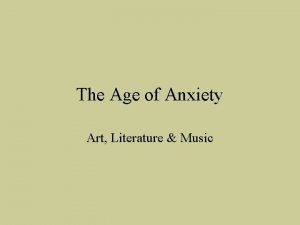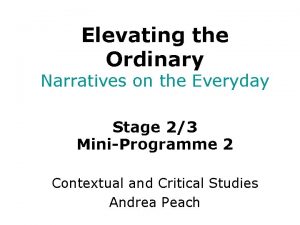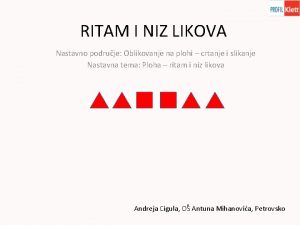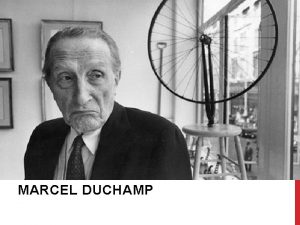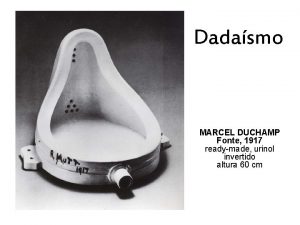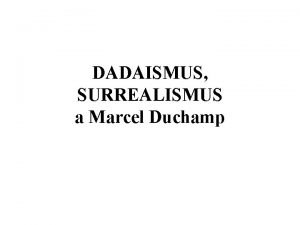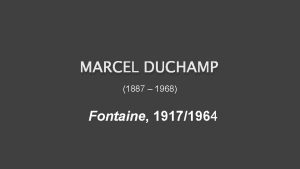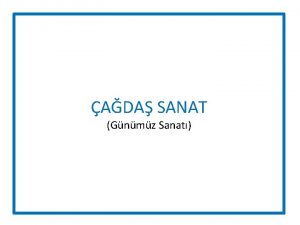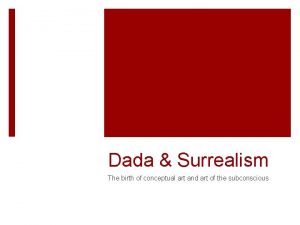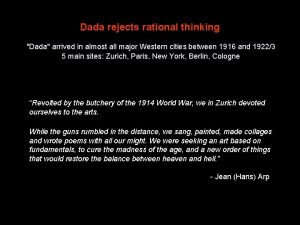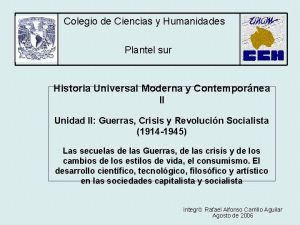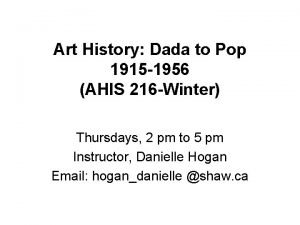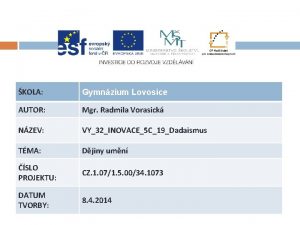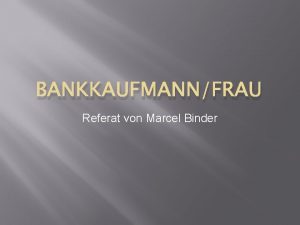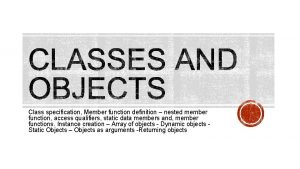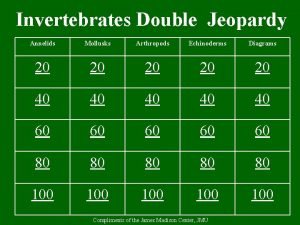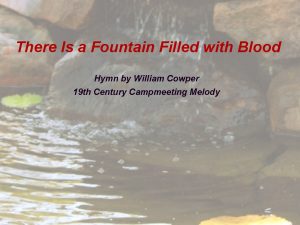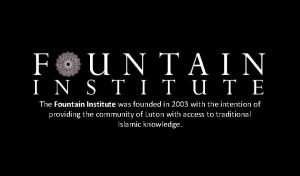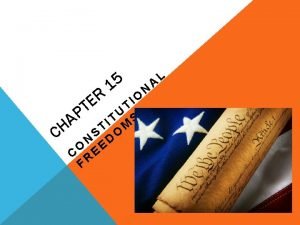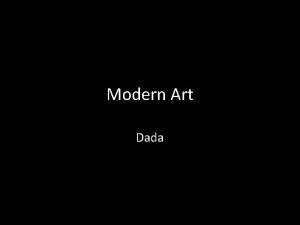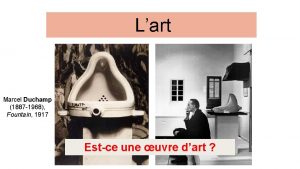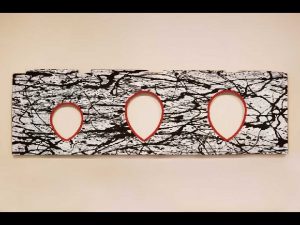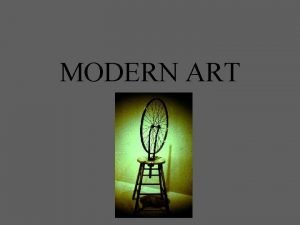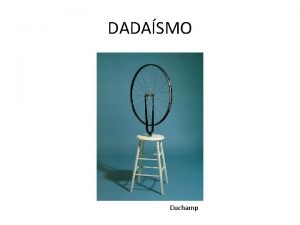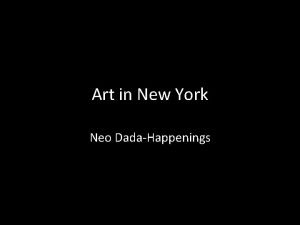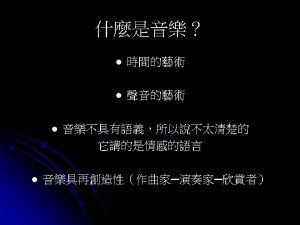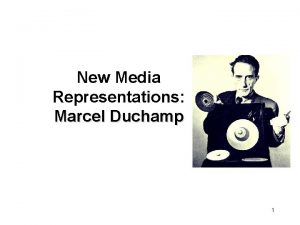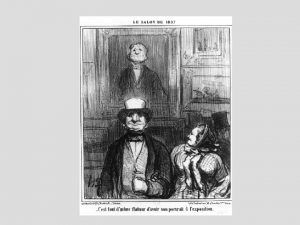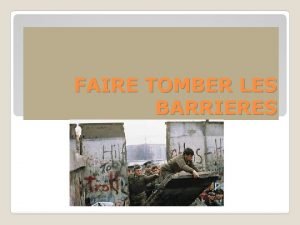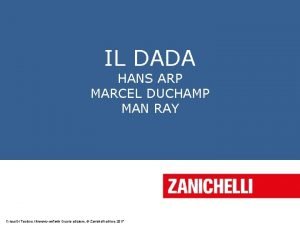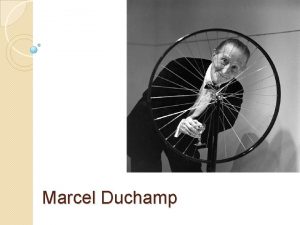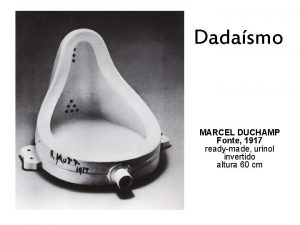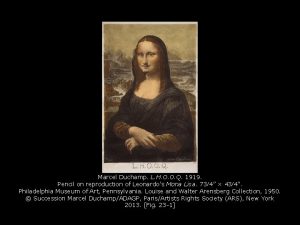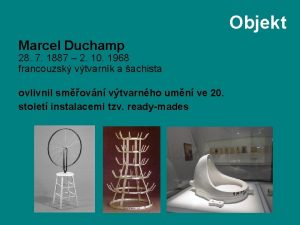1 Class 2 Defining Art Marcel Duchamp Fountain











![12 Class 2: Defining Art The Artworld (cont’d) • Artworld Systems - “[T]he artworld 12 Class 2: Defining Art The Artworld (cont’d) • Artworld Systems - “[T]he artworld](https://slidetodoc.com/presentation_image_h/3142aa334821871f48071d7e3f54f498/image-12.jpg)


















- Slides: 30

1 Class 2: Defining Art Marcel Duchamp, Fountain (1917)

2 Class 2: Defining Art George Dickie: “The New Institutional Theory of Art” Thesis: “A work of art is an artifact of a kind created to be presented to an artworld public. ” (222) Background • Found Art (“Readymade”; “Objet Trouvé”)

3 Class 2: Defining Art Marcel Duchamp, Bicycle Wheel (1913)

4 Class 2: Defining Art Man Ray, Gift (1921, 1958)

5 Class 2: Defining Art George Dickie: “The New Institutional Theory of Art” Thesis: A work of art is an artifact of a kind created to be presented to an artworld public. Background • Found Art (“Readymade”; “Objet Trouvé”) • Danto’s “Artworld” - Key question: What makes Fountain anything other than merely a urinal? - “To see something as art requires something the eye cannot descry – an atmosphere of artistic theory, a knowledge of the history of art: an artworld. ”

6 Class 2: Defining Art Background (cont’d) • Danto’s “Artworld” (cont’d) - Conceptual revolution required, allowing new art kinds to be added without removing old art kinds. • Weitz’s “Anti-Essentialism” - “Art” is too complex an idea to be defined by a single theory. - Warehouse Test - Wittgensteinian “family resemblance”

7 Class 2: Defining Artifacts • Reacting to definitions of art like Collingwood’s or Tolstoy’s, Dickie wants to maintain that a work of art is an artifact: “an object made by man, especially with a view to subsequent use. ” • But: Dickie argues that an artifact need not be a physical object (poems, etc. ). • Fountain is an artifact where the urinal is the artistic medium in the same way that the marble is the artistic medium used in creating a traditional sculpture.

8 Class 2: Defining Art Similarity Art and Non-Similarity Art • Non-similarity art (artifactual) as more basic than similarity art. Non-similarity art created by human activity of making (alteration or manipulation); similarity art created by human activity of noticing similarities. • Being a work of art is “a status achieved as the result of creating an artifact within or against the background of the artworld. ” (217)

9 Class 2: Defining Art Marcel Duchamp, Fountain (1917) men’s room urinal

10 Class 2: Defining Art The Artworld • Indiscernibles: “The fact that the first element of each pair is a work of art and the second is not although the elements of each pair are visually indistinguishable shows that the first object in each pair must be enmeshed in some sort of framework or network in which the second element is not. ” (218) - It is being enmeshed in this framework that makes the first a work of art, and the second not. • The Artist: Intends to create a thing of a kind which is presented, even if she does not actually intend to present it.

11 Class 2: Defining Art The Artworld (cont’d) • The Artist (i) is aware of her creation as “art” (ii) has an ability to use art techniques • The Public (i) is aware of the creation as “art” (ii) is sensitive to the particular kind of art presented • “There as many different publics as there are different arts, and the knowledge required for one public is different from that required by another public. ” (219) • Supplementary artworld roles: critic, art teacher, curator, conductor…
![12 Class 2 Defining Art The Artworld contd Artworld Systems The artworld 12 Class 2: Defining Art The Artworld (cont’d) • Artworld Systems - “[T]he artworld](https://slidetodoc.com/presentation_image_h/3142aa334821871f48071d7e3f54f498/image-12.jpg)
12 Class 2: Defining Art The Artworld (cont’d) • Artworld Systems - “[T]he artworld consists of a set of individual artworld systems, each of which contains its own specific artist and public roles plus other roles. For example, painting is one artworld system, theater is another, and so on. ” (221) Definition: “A work of art is an artifact of a kind created to be presented to an artworld public. ” (222)

13 Class 2: Defining Art Secondary Artifacts • “Works of art are artifacts of a primary kind in this domain, and playbills and the like which are dependent on works of art are artifacts of a secondary kind within this domain. ” (222) Circularity • “The circularity of the definitions shows the interdependency of the central notions. These central notions are inflected, that is, they bend in on, presuppose, and support one another. What the definitions reveal is that art-making involves an intricate, co-relative structure which cannot be described in the straight-forward, linear way envisaged by the ideal of noncircular definition. ” (222)

14 Class 2: Defining Art Questions & Problems (1) Dickie’s account does not solve the problem left over from Weitz’s theory: how to account for the first artwork. (2) Why don’t playbills count as artworks, with artworld systems of their own? (3) What happens if an object is removed from the artworld context? (4) Doesn’t the artworld public ultimately have to appeal to something intrinsic to identify objects as artworks? (5) Dickie’s account doesn’t seem to tell us anything about evaluation, only classification.

15 Class 2: Defining Art Jerrold Levinson: “Defining Art Historically” Thesis: “X is an artwork at t =df X is an object of which it is true at t that some person or persons, having the appropriate proprietary right over X, nonpassingly intends (or intended) X for regard-as-a-work-of-art – i. e. , regard in any way (or ways) in which objects in the extension of ‘artwork’ prior to t are or were correctly (or standardly) regarded. ” (240)

16 Class 2: Defining Art Background • Levinson is reacting to the first (1974) version of Dickie’s “Institutional Theory” – in Dickie’s original version: - One could not create private, isolated art (a work required the artworld to confer the status of “art” upon it). - The institution plays a much greater role, and does not merely play the part of the informed public.

17 Class 2: Defining Art Central Notion: • New art is art because of a relation to past art. Art of the recent past is art because it bears the same relation to art of the not so recent past… and so on, back to the ur-arts. • Ur-Art: The proto-art, or precursor to art, from which art develops, but which is not, itself, art.

18 Class 2: Defining Art

19 Class 2: Defining Art Claes Oldenburg, Floor Burger (1962) fertility goddess (primordial) Henri Matisse, Jeannette V (1916) Christo & Jean-Claude, The Gates (2005)

20 Class 2: Defining Art Central Notion: • New art is art because of a relation to past art. Art of the recent past is art because it bears the same relation to art of the not-so-recent past… and so on, back to the ur-arts. • Ur-Art: The proto-art, or precursor to art, from which art develops, but which is not, itself, art. • Three likely ways that a new work might be related to some previous work: (i) external similarity (ii) intended to afford the same pleasure/experience (iii) intended to be regarded or treated in the same way

21 Class 2: Defining Art (i) external similarity • Fails: some iron sculptures more closely resemble portions of junkyards than they do previous works of art (ii) intended to afford the same pleasure/experience • Fails: (1) pleasures/experiences derived from art are not necessarily unique to art; (2) it is the ways in which one approaches a work that gives one the pleasures/experiences (iii) intended to be treated or regarded in the same way • It is more reasonable to think the artist is concerned with what is done with the object, not necessarily with what is gotten out of the object.

22 Class 2: Defining Art Definition (first pass) “X is an artwork =df X is an object that a person or persons, having the appropriate proprietary right over X, nonpassingly intends for regard-as-a-work-of-art – i. e. , regard in any way (or ways) in which prior artworks are or were correctly (or standardly) regarded. ” (236) • intends – makes, appropriates, or conceives for the purpose of… • nonpassingly – intent cannot be merely transient • regard-as-a-work-of-art – how earlier artworks were regarded • proprietary right – you cannot ‘artify’ what you don’t own

23 Class 2: Defining Art Three Kinds of Intention (1) specific art-conscious intention (2) nonspecific art-conscious intention (3) art-unconscious intention

24 Class 2: Defining Art Definition (second pass) “X is an artwork at t =df X is an object of which it is true at t that a person or persons, having the appropriate proprietary right over X, nonpassingly intends (or intended) X for regard-as-a-work-of-art – i. e. , regard in any way (or ways) in which artworks existing prior to t are or were correctly (or standardly) regarded. ” (238) • Allows that an object may be an artwork at one time, and not another (found art). • An object may become art, long after its initial creation, if it later matches up with how art is regarded.

25 Class 2: Defining Art Circularity • Doesn’t this definition define art in terms of art? - Reflexive, not circular: it defines “being art at a given time” by reference to those things that are art at an earlier time. - “True, one cannot use the definition to tell, all at once, what has, does, and will count as art at all times, but this is because the applicability of ‘art’ at any stage is always tied to its concrete, historical realization at that stage.

26 Class 2: Defining Art Definition (third pass) “X is an artwork at t =df X is an object of which it is true at t that some person or persons, having the appropriate proprietary right over X, nonpassingly intends (or intended) X for regard-as-a-work-of-art – i. e. , regard in any way (or ways) in which objects in the extension of ‘artwork’ prior to t are or were correctly (or standardly) regarded. ” (240) • “[T]he meaning of ‘art now’ involves the extension of ‘art previously’[and] the meaning of ‘art at t’ is to be given in terms of the extension of ‘art prior to t’. ”

27 Class 2: Defining Art Problem of Revolutionary Art • What about works for which previous ways of approaching art are entirely inadequate? - Strategy 1: The artist (a) intends that his work be approached as previous works have, but also (b) intends that this approach will prove difficult, and patrons will have to alter their approach. Here, (b) is the true aim of the artist, but it requires (a) to be viewed as art at all. - Strategy 2: Revise the definition as follows: “…regard in any way (or ways) in which prior artworks are or were correctly (or standardly) regarded, or in some other way in contrast to and against the background of those ways. ” (242) – for an artwork to be revolutionary, it must nod to past works!

28 Class 2: Defining Art The Ur-Arts (and Definition, fourth pass): • “Initial Step: Objects of the ur-arts are artworks at t 0 (and thereafter). Recursive Step: If X is an artwork prior to t, then Y is an artwork at t if it is true at t that some person or persons, having the appropriate proprietary right over Y, nonpassingly intends (or intended) Y for regard in any way (or ways) in which X is or was correctly regarded. ” (243) • The ur-arts are those objects first regarded in the way that artworks would be regarded. • “What the recursive definition does […] is to generate all artworks by a method that closely parallels and illuminates the actual historical process of the evolution of art. ” (244)

29 Class 2: Defining Art Questions & Problems (1) Is the definition too inclusive? Don’t we regard some non-art things in some of the ways that we regard some artworks? Does Levinson mean “total” regard? If so, what does that mean? (2) Does the definition tell us anything about evaluation? (3) If an object was created 500 years ago, and was intended to be regarded as artworks of 501 years ago were, but is not regarded as works of today are regarded, is it no longer art?

30 Class 2: Defining Art Roy Lichtenstein, Whaam! (1963) Source for Whaam!
 The flight of icarus matisse
The flight of icarus matisse Marcel duchamp fountain
Marcel duchamp fountain Marcel duchamp art movement
Marcel duchamp art movement Nostalgia of the infinite
Nostalgia of the infinite Duchamp fountain
Duchamp fountain Key period
Key period Akt koji silazi niz stepenice
Akt koji silazi niz stepenice Marcel spears age
Marcel spears age Fonte 1917
Fonte 1917 Duchamp velké sklo
Duchamp velké sklo Vesna parun ide zima
Vesna parun ide zima Marcel duchamp fontaine prix
Marcel duchamp fontaine prix Marcel duchamp şişe askılığı
Marcel duchamp şişe askılığı Meret oppenheim
Meret oppenheim Marcel duchamp bride
Marcel duchamp bride Marcel duchamp obras
Marcel duchamp obras Readymade
Readymade Jak napsat dadaistickou báseň
Jak napsat dadaistickou báseň Bankkauffrau lehre mit matura
Bankkauffrau lehre mit matura What is non defining clause
What is non defining clause Relative clauses defining and non defining
Relative clauses defining and non defining Defining non defining relative clauses
Defining non defining relative clauses Defining and non defining relative clauses in telugu
Defining and non defining relative clauses in telugu Non-defining relative clauses cümleleri
Non-defining relative clauses cümleleri Defining or non defining relative clauses
Defining or non defining relative clauses Nesting of member function
Nesting of member function List the defining characteristics for each class of annelid
List the defining characteristics for each class of annelid There is a fountain fill with blood
There is a fountain fill with blood The gates of nehemiah
The gates of nehemiah The fountain institute
The fountain institute Colored water fountain
Colored water fountain
